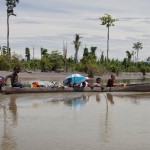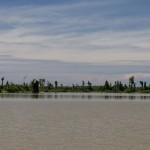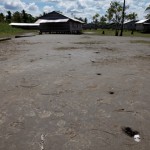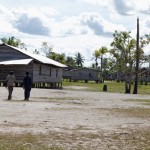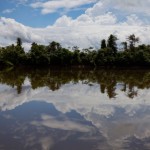Decades of Neglect: 30 Years of Ok Tedi
Decades of NEGLECT: 30 years of Ok Tedi
By Michael Main
A journey along the Fly River uncovers a serious humanitarian crisis unfolding.
This year marks the 30th anniversary of the commencement of mining operations at Ok Tedi in Papua New Guinea’s Western Province. Much has been written about that mine and the devastating impact of its method of riverine tailings disposal, and especially the landmark legal case that saw BHP effectively hand over Ok Tedi to the PNG government and exit the country, thus far never to return. However, in recent years the environmental impact of Ok Tedi, which has continued unabated, has largely retreated into the background of broader public attention.
It is worthwhile then to use this anniversary to take a look at the current situation and the ongoing impact of Ok Tedi to the environment, the people subjected to its impact, and the country as a whole.
In January this year I travelled to the town of Kiunga in PNG’s Western Province to undertake research into the impact of the Ok Tedi mine on West Papuan refugee villages located along the Fly River. Kiunga is a major inland river port through which concentrated ore from the Ok Tedi mine is piped into holding tanks and transferred to ships for export. The port is also the major supply route for Western Province as a whole.
The most striking aspect of Kiunga is that, in spite of being the gateway for one of the largest copper-gold mines in the world, the town is beset by chronic levels of poverty, unemployment, underdevelopment, crumbling infrastructure, with unserviced shanty communities constructed outside the razor-wired and security-patrolled homes of OTML employees. Whilst these scenes are not uncommon for many villages and towns in PNG that have been the focus of mining company investment, the town of Kiunga stands as testimony to the result of three decades of promised economic development from a mine that, according to PNG’s former mining minister Sam Akoitai, has at times provided up to 26 per cent of PNG’s total revenue.
As I travelled downstream along the Fly River from Kiunga, the environmental impact from the Ok Tedi mine was clear to see from the moment the mine tailings entered the Fly River at the D’Albertis Junction. Images of deforestation and grey, turbid waters are familiar to anyone exposed to media representations of the environmental condition of the Fly River.
However, it is the impact to the local population that remains under-reported and cannot be represented via aerial photographs or by publishing the scientific results of water samples in the glossy pages of a corporate report. After spending time in villages along the Middle Fly, sleeping in their guesthouses, eating with the locals and talking about their lives, it became clear that the most critical impact of the Ok Tedi mine is not due to chemical poisoning of the river, but rather the physical presence of the tailings that have thus far blanketed and choked an estimated 1,875km2 of forest. The presence of mine tailings over vast areas of low-lying flood plain either side of the Fly River has two major health consequences for the tens of thousands of people who live in that region: malaria and cholera.
The Fly River periodically floods during times of heavy rainfall, and the vast amount of mine tailings that have been dumped into the river system over the past thirty years has raised the level of the river bottom so much that the flooding is now far more frequent and lasts for much longer than it did in the past. According to Sister Moreen Sexton, an Australian nun who runs the Kiunga-based NGO ‘Mercy Works’, the Fly River is seeing three to four floods per year lasting up to ten weeks at a time. The flood waters deposit the fine-grained mine tailings over the landscape, choking the forest and making gardening impossible in the unfertile silt.
The tailings also change the topography so that natural drainage pathways for rainwater are blocked. This results in houses, which are all built on stilts, standing over permanent pools of stagnant water that provide the ideal breading environment for malaria-carrying mosquitoes. Every member of the village where I stayed was confined to their mission-supplied mosquito nets from sundown as the air became thick with the mosquito plagues that rose from beneath their houses. The severity of the mosquito problem is directly related to the presence of mine tailings in the river. The frequent flooding also causes problems with the disposal of human waste and associated diseases that are easily spread when pit toilets are overrun by flood waters.
In 2010 Western Province saw PNG’s first major outbreak of Cholera since the 1960s. High rates of disease that are endemic throughout the Fly River region, including the cholera outbreak which in 2010/11 killed around 500 people, is caused by the combined effect of state neglect and the physical impact of the mine tailings that have disrupted the lives of countless people who live amongst the discharge of PNG’s largest mine.
In Kiunga I interviewed Robin Mokin who is currently advisor to Provincial and Local Government Affairs. As a prominent member of the Yonggom community that pursued the legal case against BHP in the 1990s, Robin was one of the leaders who negotiated the terms of settlement that allowed the mine to continue in return for benefits to the tens of thousands of people impacted by the mine. Robin informed me of government plans to relocate the entire population living along the Fly River to higher ground along a proposed road to be built from Aiambak to Kiunga. In negotiating with the West Papuan Muyu refugee population living along the Fly River Robin uses the Muyu word nombaranen (extinct) to convey the risks they face in remaining in their villages. He tells them, “you will become extinct, you will be wiped out” if they remain where they are. Robin fears further outbreaks of cholera and other diseases that will only increase in severity as the tailings impact continues to increase.
The PNG federal government is aware of this as well. In 2008 the Fly River Provincial Government Development Plan cited the need to establish “growth centres” where people living along the Fly River could be moved to higher ground and used to further develop the struggling rubber industry. According to the UNHCR the flooding of the Fly River that is caused by the accumulation of mine tailings has prompted the Provincial Government, in conjunction with Ok Tedi Mining Limited, to develop the concept of growth centres located away from flood-affected areas so that the entire population of these areas can be relocated (approximately 30,000 people). At the end of 2012 the UNHCR observed, “So far, these plans have not been realized due to lack of funding and the concept is not well developed for implementation.”
The failure to produce broad-based development outcomes has been the economic hallmark of the Ok Tedi mine over the full thirty years of its operation. This result mirrors the experience of extractive industry across the entire country, which was recently acknowledged in the recent UNDP 2014 National Human Development Report for Papua New Guinea. In its assessment of PNG’s low ranking on the Human Development Index the UNDP observes, “…this extractive-based form of development has not been inclusive or reached as many Papua New Guineans as it could and should have.”
In the case of Ok Tedi this extractive-based form of development has not only failed to produce widely distributed, sustainable development outcomes, it has also created an ecological disaster that has the potential to develop into a humanitarian catastrophe if drastic measures are not taken to move vast numbers of people from a landscape that is fast becoming uninhabitable.
This long-term economic and humanitarian liability that has been created by the Ok Tedi mine is not referred to in the recent UNDP report, and nor is it being publically acknowledged either by the mining company or government. However, like the slow-moving build up of mine waste in the river system that has occurred unabated over the past thirty years, the day the PNG government will be forced to act in the face of a full-blown humanitarian crisis is creeping ever closer.
This week the PNG Prime Minister, in conceding to “decades of neglect” towards the people of Western Province, announced that ownership of one third of Ok Tedi is to be handed over to the province in a decision described as “fair and just.”
Yet it is hard to see that the problems facing the people along the Fly River can be understood in terms of a lack of money. The problem relates to a presence, not an absence. The presence of immense volumes of mine tailings in the river and on the plains, and the presence of tens of thousands of people currently living in the impact zone. Getting rid of one presence, that of the people, is surely a ham-fisted policy that will create a raft of social ills that may well render the cure far worse than the disease. Policies that tackle the presence of mine tailings; whether through civil engineering projects, building a tailings pipeline, and even ceasing mining operations altogether, surely warrant serious consideration before any such social engineering solution is even contemplated.
References: ‘Akoitai: Shut Ok Tedi Mine’, Islands Business, http://www.islandsbusiness.com/news/papua-new-guinea/3597/akoitai-shut-ok-tedi-mine/ Ok Tedi Mining Limited, ‘Annual Environmental Report’, September 2013. http://www.sbs.com.au/news/article/2010/11/09/png-cholera-outbreak-reaches-torres-strait http://www.theglobalmail.org/feature/up-the-fly-without-a-paddle/523/ UNHCR Memorandum of Agreement on Continued Support Services in Border Camps of Western Province, 17th December 2012 http://www.radionz.co.nz/international/pacific-news/261810/png-pm-gives-third-of-ok-tedi-to-western-province
